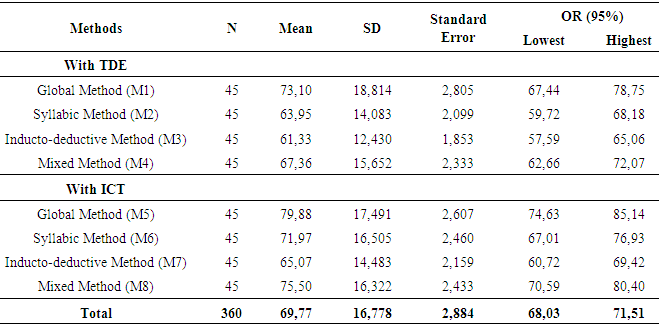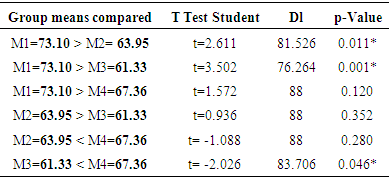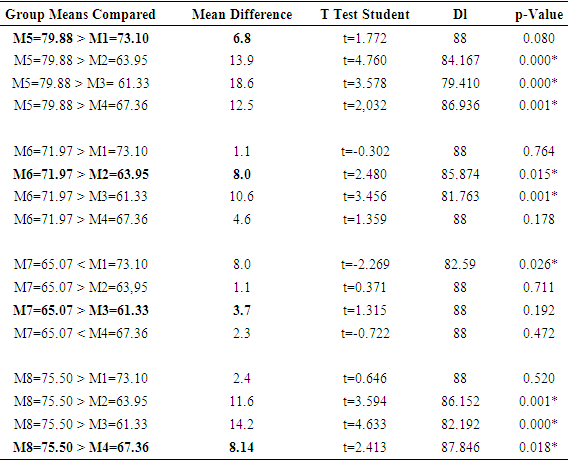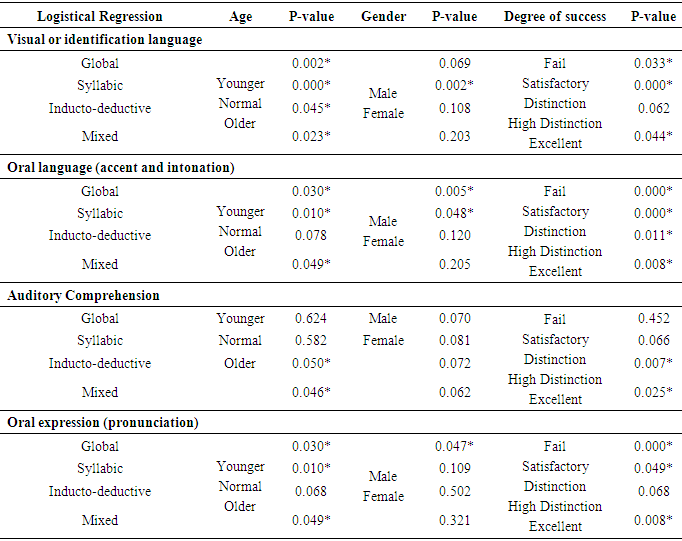-
Paper Information
- Paper Submission
-
Journal Information
- About This Journal
- Editorial Board
- Current Issue
- Archive
- Author Guidelines
- Contact Us
Education
p-ISSN: 2162-9463 e-ISSN: 2162-8467
2017; 7(6): 112-123
doi:10.5923/j.edu.20170706.02

Effectiveness of the Teaching Methods of Elementary Reading on Pupils’ Academic Performance
Corneille Luboya Tshiunza 1, Simon Kaukungwa Shilongo 1, Guillaume Bofio Bina 2
1School of Education, Central China Normal University, Wuhan, China
2School of Psychology and Educational Sciences, National Pedagogical University, Kinshasa, DR Congo
Correspondence to: Corneille Luboya Tshiunza , School of Education, Central China Normal University, Wuhan, China.
| Email: |  |
Copyright © 2017 Scientific & Academic Publishing. All Rights Reserved.
This work is licensed under the Creative Commons Attribution International License (CC BY).
http://creativecommons.org/licenses/by/4.0/

In most of developing countries, many graduated pupils of primary school have very lower skills in reading. For example in Democratic Republic of Congo (DR Congo), 50% of pupils of elementary degree of primary school have learning difficulties, especially in reading. It has proved the importance of teaching methods on the pupils’ performance in reading. This comparative quantitative and quasi-experimental study conducted with 360 pupils from eight primary schools, aims to test the effectiveness of four teaching methods used with TDM and ICT in teaching reading in order to determine what a teaching method contributes to higher performance of pupils in reading or what among four methods would be most suitable. The findings could help teachers to select the best method to adopt in their teaching.
Keywords: Teaching Method, Elementary Reading, Teaching of elementary reading, Global, Syllabic, Mixed and Inducto-Deductive Methods
Cite this paper: Corneille Luboya Tshiunza , Simon Kaukungwa Shilongo , Guillaume Bofio Bina , Effectiveness of the Teaching Methods of Elementary Reading on Pupils’ Academic Performance, Education, Vol. 7 No. 6, 2017, pp. 112-123. doi: 10.5923/j.edu.20170706.02.
Article Outline
1. Introduction
- Several studies on the effectiveness of teaching methods, for example the “Follow Through” project brought back by Slavin (2002), the studies of Evans and Carr (1985), Stallings, Cory, Fairweather, and Needels (1978) on impact of Direct Instruction on student academic achievement; the experiment of Zahorik, Molnar, Ehrle, and Halbach (2000); the study conducted by Molnar, Smith, Zahorik, Halbach, Ehrle, Hoffman, and Cross (2001) reported on the National Reading Panel and the meta-analysis of Borman, Hewes, Overman, and Brown (2002). All of these studies showed the relationship between the effectiveness of the teaching methods and the pupils’ academic performance in primary schools.In most developing countries as DR Congo, the level of reading of pupils is low in the elementary phase of schooling. The success mean from the International Test-PASEC-RD Congo (2010 in RD. Congo-MINEPSP, RESEN, 2014) on the reading ability of pupils in the second year was 50%. The main question arising from these revelations is: why are there such remarkable weaknesses in reading? This situation can be attributed to several factors, many of which relate to the teaching methods. The reading skills are supposed to have been acquired already in the first two years of primary education; this is also the phase where most cases of learning disorders, in particular dysgraphia, dysorthography and dyslexia, are detected. This study focused on the teaching methods of reading in elementary school. With regard to the teaching of reading, DR Congo’s National curriculum of Primary Education (PNEP, 2014) recommends four possible teaching methods and educational equipment for the teachers. The purpose of this quantitative and quasi-experimental study was to test the theory of the positive effects of an effective teaching method by comparing the effectiveness of different teaching methods used in elementary reading on the pupils’ academic performance, while controlling the socio-professional characteristics of the teachers, the socio-economic characteristics of the parents and the targeted population of second year pupils in primary school. The four teaching methods are: (i) the global method, (ii) the syllabic method, (iii) the mixed method (global and syllabic) and (iv) the inductive-deductive method. Teachers have the liberty of choosing one of these teaching methods based on the educational tools available. It should be noted that currently in DR Congo (Kinshasa); certain viable schools are equipped with Information and Communication Technology (ICT) equipment for teaching. This study sought to answer the following research questions: What teaching method is most effective for teaching reading to pupils in primary schools? Is there a statistically significant difference in the pupils’ academic performance based on the various teaching methods for elementary reading? The study attempted to test the following two statistical assumptions: Null hypothesis (Ho): There is no statistically significant difference in the pupils’ academic performance in elementary reading when taught using the various teaching methods (global, syllabic, mixed and inducto-deductive) with either traditional didactic equipment (TDE) or information and communication technology (ICT) equipment. Where M1=M2=M3=M4=M5=M6=M7=M8.Alternative hypothesis (H1): There is a statistically significant difference in the pupils’ academic performance in elementary reading when taught using the various teaching methods (global, syllabic, mixed and inducto-deductive) with either traditional didactic equipment (TDE) or information and communication technology (ICT) equipment. Where M1 ≠ M2 ≠ M3 ≠ M4 ≠ M5 ≠ M6 ≠ M7 ≠ M8.
2. Theoretical Perspectives
- Teaching Method or Method of TeachingIn education, the teaching method is understood as a rational and logical way used to help the pupils to learn something. According to Ibeki (2007:194), the teaching method is the general, structured and logical approach which dominates during a lesson with the purpose to help pupils acquire knowledge. It is structured and organized diagrammatically and composed of different stages in order to attain the intended goal. It is also described as “logical” because it must have a scientific foundation and a coherent sequence. The use of a good teaching method is associated with multiple benefits. Such benefits include: facilitating a teacher to progress easily while avoiding fumbling in his or her lesson; improving the outcomes in a given class; saving time as well as energy; and effectively achieving the set objectives. However, despite these multiple benefits, the choice of method depends on the nature of the pupils who form a class (age, capacities or average intellectual level, pre-assets, etc.), the discipline of teaching, the assigned time, the climate of the class and the requirements particular to the method used.Elementary Teaching of Reading To read is to extract from a graphical language the pronunciation and the significance which corresponds with it. It is also to transform the graphical signs into phonetics by associating directions and mental and somatic faculties. Actually teaching reading consisted of four components of language such as reading, speaking, writing and listening into other subjects of the curriculum (Irwin, 1967). Kemba, (2005: 28) states that in teaching of reading the “connections are made between disciplines, such as science and language arts, and taught through conceptual themes, such as inventors or the weather”. The contemporary perspective of reading is that the pupil is an active learner. Learners interact with new information based on their previous knowledge and experiences. They build their own knowledge base by deriving their own meanings from information, connecting new concepts and skills to what they already know. Children do not always understand what precision in meaning demands and are also unable to call to mind what words they require in speech and writing and apply them correctly (Irwin, 1967). In DR Congo, elementary reading is a set of principles which organize the orientation and implementation of the teaching of reading at the beginning of primary school. It is the kind of reading taught in the first phase of the first three years of primary school. In the elementary phase, the emphasis is usually on the following: French alphabet in two groups: vowels and consonants, and in six groups: (1) the generating letter “e”; (2) letters of group “c” (c, o, a, d, g); (3) letters of group “l” (i, f, b, h, k, t); (4) letters of group “i” (i, u, j, p, s, r, z, o, u, z); (5) letters of group “n” (n m v w, y); (6) capital letters (according to their form: A, M, NR – I, F, J, H, K, T, Z – Q, L - D – Q, E – P, B, R – O, C – U, Y – V, W). In addition, pupils also have to study the sounds, words, syllables, and the formulation of simple sentences on several topics, such as family, parts of the human body, study of a local area, the school, clothing, events, food, the dwelling, fauna, flora, transport, communication, games, colours and the market (DR Congo’ National Curriculum of Primary Education, 2014).Theoretical Models of the Teaching Methods of Elementary Reading With regard to the teaching of elementary reading, this study confirmed that most of the teachers are still confined to the didactic models elaborated and suggested by the official methodological directives of Ministry of education. The debates focus on the polarity between “global methods” and “syllabic methods”. In the first case, the pupils memorize all the words, whilst in the second, the pupils need to memorize letters associated with sounds and syllables, and interpret the words starting from these units. In DR Congo four didactic models have been described and distinguished.The Inducto-deductive Method involves two processes. The first is the inductive process, which includes concrete examples, observable cases, rules and general principles. The second process is the deductive process which includes the rules or general laws stated which lead to experiments and applications. It is generally about using the general rule of the formula and the general principle to arrive at the concrete examples or observable cases. The Global Method moves from the complex and comprehensible elements (sentences, words) to the simple and non-comprehensible elements (syllables, letters, words or sounds). This method is also called “analytical” because it mainly focuses on examining pupils in detail. Sometimes it is referred to as “ideo-visual” because it goes primarily from the idea presented by the child to the knowledge of the real image of the object (Claparède, 1908; Wallon 1952, 1953; Hamaïde, 1946; Seger, 1926, 1939; Foucambert, 1986; Beaume, 2006). However, the Phonetic or Syllabic Method is also referred to as the method of epilation. The method is associated with the verb “to spell” and therefore mainly focuses on the letters, syllables and sentences. It is described as “epilation” because it helps pupils to learn letter by letter. It is known as “phonetics” because it is the starting point in the study of sounds (Bryant, 1990; Joshi, Leong and Kaczmarek, 2003).The Mixed Method (Global and Syllabic) is called “semi-global or semi-syllabic method” and combines the advantages of the two methods. The mixed method presents many varieties in its application. The semi-global method resembles the global method because it starts from sentences and recognized words. It resembles the synthetic or syllabic method because the pupil learns each letter in turns without delaying. Thus, the child can acquire the skills of reading, writing, calculation, and resolution of problems and the aptitude to continue to learn. This method requires the child to observe things, facts and phenomena and describe them, judge them and reason, i.e., to act and to think by combining the four categories of language (reading, verbal expression, writing and oral comprehension) (Brighelli, 2005). In DR Congo, teachers generally use these various methods together with traditional didactic equipment (TDE) which can be natural or artificial, manufactured or bought, coming from plants, animals or from decorative and coloured images. Some teachers in schools equipped with ICT use technological equipment such as television, video-projectors and computers. The two alternative tools (TDE and ICT) associated with the four methods mentioned above make a combination of eight methods. This study attempted to test the effects of these eight methods on students’ academic performance.Legrain (2003) displays the results of Mingat’s (Institute for Research in the Sociology and Economics of Education, Dijon) study, which sought to determine the importance of various factors on academic success. Indeed, these results showed 70% of the causes of the variation in the degree of success. 50% of the variations in success were allotted to the particular characteristics of the pupil. The remaining 20% were distributed between logistics and means (5%) and the methods of teaching used by the teachers (15%). With regard to logistics and training, Marty (1996) carried out a research related to the practices of reading and writing in primary school using new technologies. Marty observed that in Parisian schools, pupils carry out the tasks of reading and writing in front of computers, with the guidance of adults and in co-operation with peers. She concludes that the child can develop new linguistic competences within the school framework through the use of information and communication technologies (ICTs) and through interaction with more experienced adults and other pupils.Audran (2001: 385) considers the reciprocal influences related to the use of new ICTs by the actors in the school. He found that the ICTs are used in class by the teachers, on the one hand to complement the traditional methods; while on the other hand, they use ICTs for their own personal benefit. Several studies show that ICT increases motivation in training. The most quoted motivational aspects of ICT in education research are, as Karsenti, Brodeur, Deaudelin, Larose, and Tardif (2002) point out: (i) they are more compatible with modern equipment or mediums; (ii) there is a possibility of greater autonomy in learning; (iii) the nature of the training is more personalised; and finally (iv) there is a possibility of regular and faster feedback (Karsenti, Fortin, Larose and Clément, 2002).Balanskat, Blamire & Kefala (2006) conducted a study carried out in in national, international, and European schools, with the aim of gathering evidence regard to the advantages and benefits of ICT in school achievements. The findings showed a positive impact on student performance in primary school, particularly in English language, although the effects are less significant in the sciences. ICT also develop some writing skills: spelling, grammar, punctuation, editing and re-drafting. Still new technologies encourage independent and active learning, and students’ responsibility for their own learning (Pedretti, Mayer-Smith and Woodrow, 1998; Passey, 1999; Ofsted, 2002; Lewin et al, 2000).The four abovementioned methods can also be effective when used together with either traditional didactic equipment or technological equipment. The latter also has its effects on the output of the pupils due to their nature. Traditional didactic equipment (TDE) and ICTs have therefore proven to be equally effective. It should also be stressed that certain variables, such as age may influence pupils’ performance. Gilly (1965) highlights the influence of age on school performance and concludes that the younger children do have the chances to achieve the higher performance but the pupils who were normal or old age of schooling were achieved the higher performances. With regard to the gender of pupils, Fouedjio (2008) study found that girls improved in their reading scores by 65%, while boys’ performance scores improved by only 30%. This seems to suggest that boys are more gifted in mathematical disciplines and girls are better with the languages or arts.
3. Methodology
- Research Design This study was inspired and based on the epistemological paradigm of positivism and the quantitative approach (Tashakkori & Teddlie, 2010; Creswell, 2014). The study is the second level of research in education, using quantitative and quasi-experimental methods to compare the impact of the four teaching methods when used with either TDE or ICT on the elementary reading of pupils from eight primary schools. ParticipantsWe decided on a nonprobability sample taking into account the nature of this study (Babbie, 1990; Fink, 1995). The data collected from the annual reports of inspection of national schools. Firstly, we compiled extracts of the purposive sample, composed of eight primary schools in various educational provinces (Kinshasa East, West and Central in DR Congo), taking into account the methods used in the teaching of elementary reading in second year of school. Secondly, we looked at the attendance registers of the eight schools chosen to constitute the sample. The inclusion or exclusion criteria of pupils were as follows: (i) being a registered pupil and regularly attending a selected class in the schools participating in this study; (ii) having French language as mother tongue; and (iii) having a normal IQ (DSM-IV) based on the intelligence test of Cattell (1937) Version 2a and the Catch Test of Florence Goodenough (1926), which constitutes the average speed to detect the level of the intelligence of children from 3 to 14 years. Below is the summary of results of the test done on selected pupils by school.The initial sample consisted of 480 pupils from the eight targeted schools, i.e., 60 pupils per school. However, only 360 pupils (45 pupils per school) who had the required IQ (between 110 and 121) were retained (Horn, J., 2001). Overall, the school performance mean of the pupils oscillated between 60% and 68% per class or school, which was higher than the mean envisaged by the national criteria (50%). The girls accounted for 49.2% of the sample compared to 50.8% for the boys, while the pupils’ age mean in the study sample was 7.13 years. The pupils’ IQ general mean on the Cattell 2A Test was 112.77. However, for the Catch Test the mean was 113. We used the nonparametric test of Wilcoxon to compare the difference between the IQ obtained from the two tests by study subject (T = 183; NR = 5; α = 0.05; Tob = 183; T α = (.05) = T obs.). Therefore there was no difference. The following can be noted from this summary table:
|
4. Results
- After survey, management and analyses of data, expected results are presented according to our research questions as follows:Effectiveness of the methods on pupils’ academic performance The table below shows the summaries of the descriptive statistics, the homogeneity of the variances and results of the analysis of the variances.
|
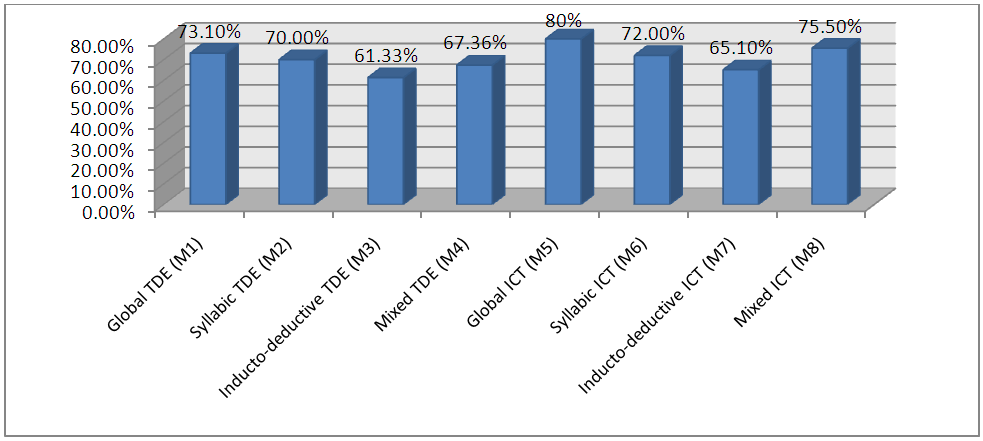 | Figure 1. Means of pupils’ performance by teaching method |
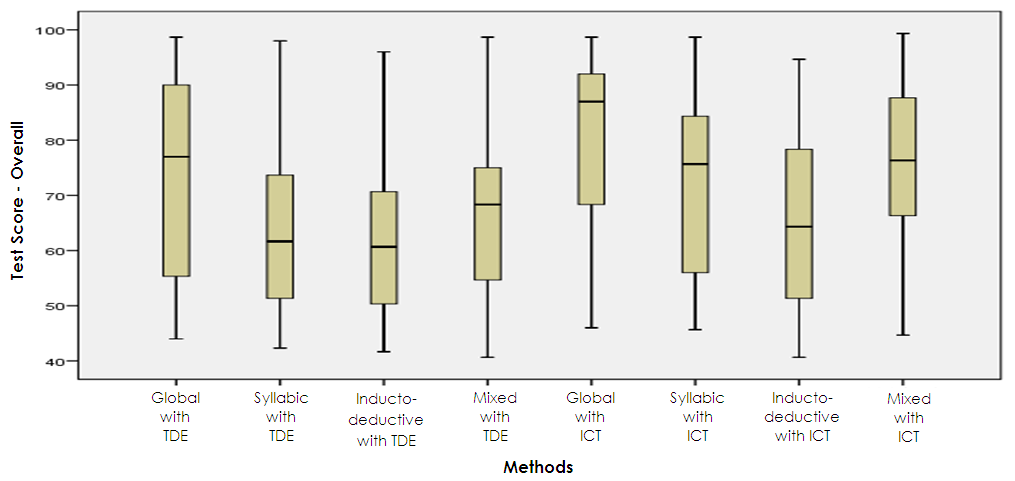 | Figure 2. Overall test scores of the different methods |
|
|
|
|
|
|
5. Discussion
- What are the research findings?From a national perspective, any teacher has the freedom to choose any method from among the four teaching methods depending on their preference and experience. This study helps teachers to reflect and develop an experimental attitude in the choice of teaching methods for elementary reading. During the study, some of the detected causes of failure in the teaching of elementary reading were endogenous causes (e.g., dyslexia, dysgraphia, dysorthography, etc.) and exogenous causes (e.g., overpopulation of the classes; school absenteeism due to sickness or non-payment of schooling fees; lack of monitoring and moral support of pupils by the parents; non-conducive family environment; conditions of teaching; sociocultural and socio-economic factors of the pupils and parents). However, when those exogenous factors are minimised by experimental approach, the pupils’ weakness in reading could also be explained by bad choice of method made by the teacher from the possible alternatives proposed by the National curriculum, official directives and instructions. The choice of teaching methods should therefore take into account the experimental study, the age group and the gender of the class. This study focused on pupils’ performance using the four teaching methods of elementary reading with two alternatives (TDE and ICT). This quantitative and quasi-experimental study show the presence of significant differences in four teaching methods of elementary reading in the pupils’ academic performance in second year of primary school. These differences are also present in the two alternative tools used with these methods, traditional didactic equipment (TDE) and information and communication technologies (ICTs). Based on the means of the different teaching methods for both TDE and ICT, the global method had the highest effect, followed by the mixed method, then the phonics (or syllabic) method and finally the inducto-deductive method. Statistically, among four methods used with TDE, the global method was found to be equal to the mixed method but higher than the syllabic and inducto-deductive methods. No difference was observed in the inducto-deductive, global, syllabic and mixed methods. The mixed method was higher than the inducto-deductive method. The results of these four methods used with ICT were the opposite of those observed using TDE, except for the syllabic method which statistically proved its superiority above the inducto-deductive method. What are the finding of this study compared to other studies? It is worth mentioning that there was a statistically significant difference in performance between the two alternatives (TDE and ICT) used with the inducto-deductive method and the mixed method. In other words, the inducto-deductive and mixed methods with ICT had greater effect on the performance of the pupils. Several studies show that ICT improves motivation in training. Similarly, Karsenti et al, (1999) points out that the use of ICT is more focused on working with a new system or medium; has the possibility of greater autonomy for learning, has the advantages of being more personalised and giving regular and faster feedback (Karsenti, Fort, Larose & Clément, 2002). Compared to the variables such as age, gender and degree of success of these methods, overall, the normal school-going age in the country for second level (7 years) in this experience had a significant effect on the pupils’ performance and degree of success using the four methods. This result is related to those of Gilly (1965). Moreover, the pupils who are delayed are generally classified negatively, while those who take the lead are generally classified positively. The performance of the pupils in visual language in elementary reading during the use of these four methods was also affected by the age of pupils. However, girls were stronger in visual language during the use of the global method. Moreover, except for the inducto-deductive method, the other three methods predicted the quality of the performance of the pupils on visual language. Oral performance (accent and intonation) using the global and syllabic methods were affected by the age of the pupils. The use of these two methods also improved the performance of girls in oral language. Nevertheless, all the four methods had an effect on the quality of performance in oral language. Fouedjio (2008) arrived at the similar conclusion. This seems to suggest that girls are more gifted in the languages or arts disciplines, while boys are more gifted in the mathematical disciplines. The performance of the pupils in auditory comprehension using the inducto-deductive and mixed methods is also affected by the respective official age of school of the pupils in the particular school. In addition, the use of these two methods affected the quality of performance of the pupils in auditory comprehension. However, the performance in oral expression (pronunciation) was affected by the respective official age in the different schools during the use of these methods, except for the inducto-deductive method. Only the use of the global method had an effect on the performance of girls in oral expression. The use of all the four methods affected the quality of performance in oral expression. Why some methods are more effective than others?The study established the superiority of the global method above the other methods on the one hand, and the predictive effect of the respective official age on the quality of academic success using the methods on the other hand. This calls for reinforcement of the policy with respect to allowed school ages and the orientation of teachers in the choice of methods in elementary reading. In this study, emphasis was also placed on the importance of equipment or modern teaching tools (ICT) to improve the effectiveness of the methods used in elementary reading. The present study is in line with the studies carried out in national, international, and European schools, with the aim of gathering evidence regarding the advantages and benefits of ICT in school achievements. The study sought to measure the impact of ICT on student performance by trying to establish a link between the use of ICT and students’ results in examinations. The findings are interesting. ICT has shown a positive impact on student performance in primary school, particularly in English language, although the effects are less significant in the sciences (Balanskat, Blamire & Kefala, 2006).The global method used with TDM or ICT proved its superiority (effectiveness) in comparison with other methods. These results are justified in sense that half of the children in the elementary grades of primary schools in RD Congo (50%) has difficulties of training of reading in French. This method proved its effectiveness from the children in training difficulties (Wallon 1952; Jalley, 2007). The method seems more adapted to the psychology of the pupils in normal training or in difficult of training. It exploits well the total or global perception as well as the spontaneity of the pupils. It seems obvious when we surveyed 78% of the pupils in elementary grades of primary schools in RD Congo (between 6 and 7 years) are among the age between the conception and the stabilization of global perception or overview (Claparède, 1908; Wallon 1952; Simon, 1954). It is about the age of the growth of the analytical or global intellectual faculties manifested by the activities of overview, of ideographic visual, ideo-visual, natural-visual or any other intelligence visual of development of child psychology. The global method used, therefore, is adapted to their physical development or their mental growth.Although the debates of teaching methods of reading carried out generated controversy among the specialists, however, some specialists of methods of reading and child psychology state that the global method is among the best reputed pedagogic strategies of teaching-leaning of reading (Claparède, 1908; Wallon 1952, 1953; Hamaïde, 1946; Segers, 1926, 1939 Foucambert, 1986). Decroly (cited by Wallon 1952) explain that global activity of human perception makes the bridge between instinctive activity and upper intelligent activity. It works spontaneously in the children and allows important acquisitions such as language, knowledge on physical or materiel, living and social environment and adaptation to the series of author forms of activities related to cognitive, conative and motor human aspects. The specialists of this method estimate, for example, that mothers often use this method unconsciously to educate their children before school age or over school time to make them acquire various important techniques, notably language. It is necessary to add that the global method is applicable not only in introductory learning techniques (reading, writing, orthography) but also in the branches of knowledge relating to nature and human being (natural science, history, geography) and in the expression of this knowledge in the mother tongue or in acquisition of another second language (Beaume, 2006; Jalley, 2007; Dehaene, 2013).In additional, the syllabic method used with TDM comes second in position following by the mixed methods and indicto-dedutive; while the mixed method with ICT is placed in second position by its effectiveness. Using ICT, the mixed method increases its effectiveness more than the other methods. It is observed that the mixed method at the same time draws its effectiveness with the enrichment brought by the advantages from the combination of the other methods used. It is held in a precarious balance between global visual approach and synthetic method (Brighelli, 2005). Moreover, the ICTs with its effects encourage and motivate the pupils in the learning of reading. They support and maintain the length of attention of the pupils by the images and bright colors used in its demonstrations. The ICTs used with teaching methods made leaning activities less boring and more interesting. The pupils are motivated to read or to pronounce aloud what they perceive. These similar conclusions were drawn by several studies at the usage of ICT in teaching-learning in primary or secondary school. ICTs allow for higher quality lessons through collaboration with teachers in planning and preparing resources (Ofsted, 2002). Students learn new skills: analytical, including improvements in reading comprehension (Lewin, 2000). ICTs also develop some writing skills: spelling, grammar, punctuation, editing and re-drafting (Lewin, 2000). Still new technologies encourage independent and active learning, and students’ responsibility for their own learning (Passey, 1999). ICTs prove that students who used educational technology felt more successful in school. They are more motivated to learn more and have increased self- confidence and self-esteem. It is also confirmed that many students found learning in a technology-enhanced setting are more stimulating and much better than in a traditional classroom environment (Pedretti et al, 1998).What are the limitations of the study and research perspectives?This study focuses only on 360 pupils of elementary grades of primary school hiving French as mother tongue. Therefore, it may not produce the same effects when generalized, but it helps as a reference point to enhance and enrich the national debate on the effectiveness of teaching methods in elementary reading. It would be unrealistic to think that there exists only one teaching method applicable everywhere. This study can however be regarded as a starting point. It should also be kept in mind that when used in isolation (without TDM and ICT), each teaching method may have only marginal effect. It is, therefore, the combination of methods that strengthens the teaching of reading. More longitudinal studies on teaching methods of reading need to be conducted on the same or higher level.
6. Conclusions
- In conclusion, we reiterate that modification of teaching practices is essential to ensure the academic success of pupils. However, in the light of the results presented in this study, each method must be consequently and judiciously selected by the teacher. The method is of major importance in the teaching and learning, because each lesson requires a suitable method.The method used by the teacher to conduct his or her lessons can stimulate the efforts of the learners and help them to learn, but can also be responsible for the failure of learners. When the teaching method is not effective, it will be difficult for learners to acquire the necessary skills for reading, writing and oral expression, or to facilitate the future learning of several types of reading (quiet reading, loud reading, expressive reading and explanation).The success of a teaching method depends largely on its user, who must use his teaching experience and his personal qualities such as: the art of public speaking, constant effort to seek comprehension or clarity, experimenting, tips, etc. The teacher’s scientific competence also has positive effects on the practical teaching of communication. These are useful measures to circumvent difficulties and improve pupils’ performance. A teaching method can be recommended only after having checked its effectiveness on the field and under the necessary experimental conditions. This study recommends the use of the four teaching methods (specially global and mixed methods) with the two alternative tools (TDE and ICT) taking into account the gender (girls or boys), age (younger, normal and older) and degree of success (satisfactory, distinction, higher distinction or excellent) of the class. Also, the reading aspects to be developed should be considered, e.g., visual language or identification; oral language (accent and intonation); auditory comprehension; and oral expression (pronunciation). This study can sensitize the main actors in education to this reality.
 Abstract
Abstract Reference
Reference Full-Text PDF
Full-Text PDF Full-text HTML
Full-text HTML
